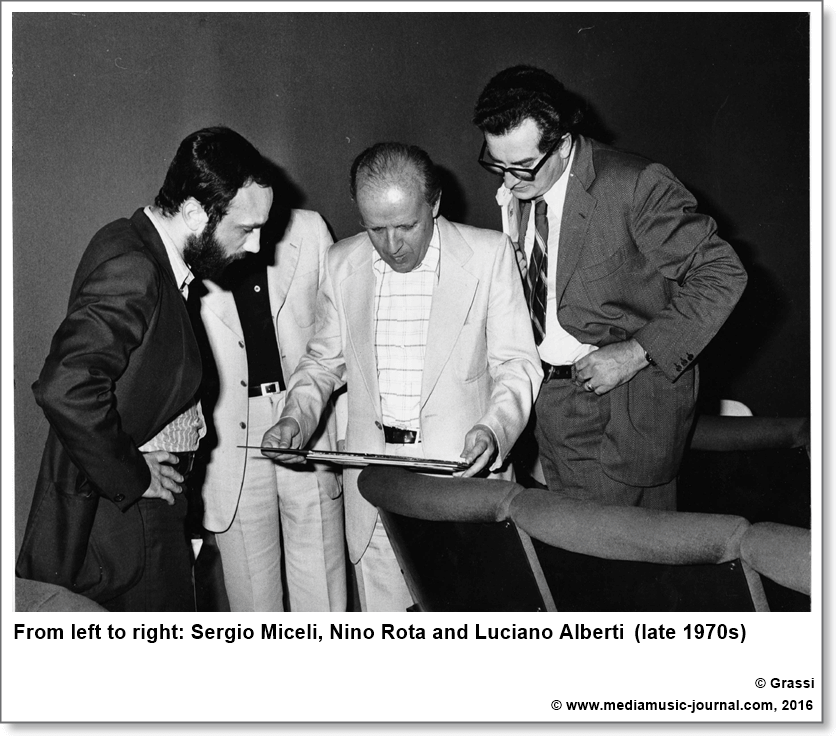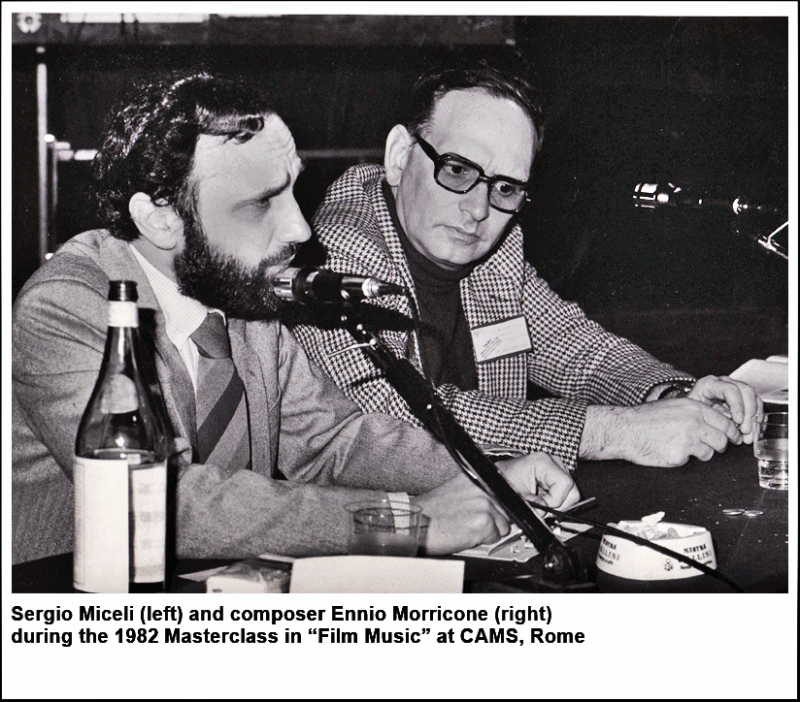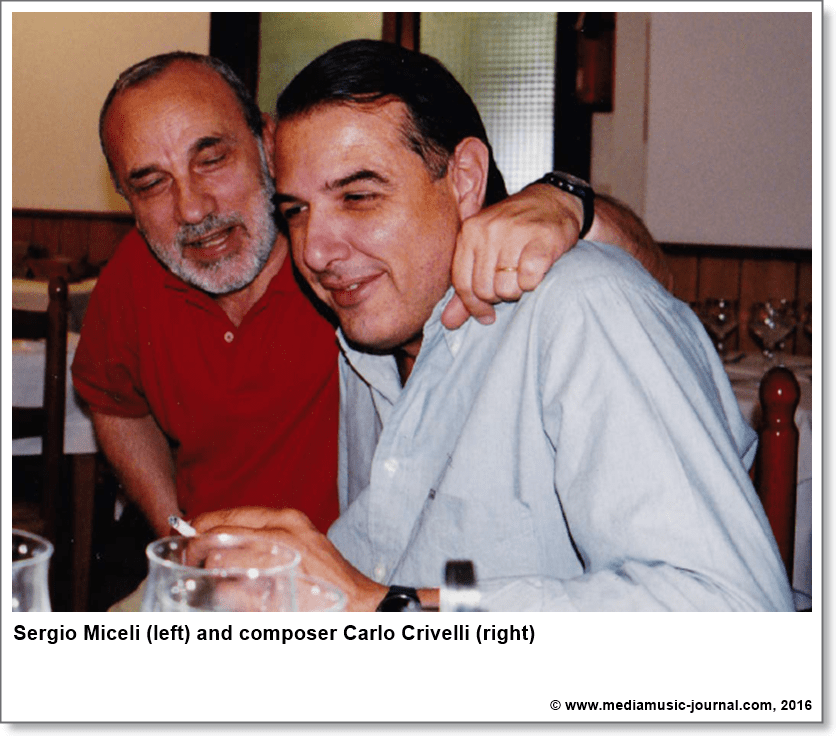Sergio Miceli and the Italian way to international film music studies
On July 2nd 2016, the Italian musicological community of film music studies has lost one of its first and leading scholars, Sergio Miceli. Since the late 1970s, Miceli dedicated most of his academic activities to the systematic study of music in cinema, considered both from a historical and a theoretical point of view. Though not being, obviously, the very first Italian musicologist to deal with cinema — consider, for instance, Sebastiano Arturo Luciani (1884-1950), Guido Maggiorino Gatti (1892-1973) and Massimo Mila (1910-1988), — Miceli had a foundational role in the development of Italian film musicology as a distinct and recognizable disciplinary field, with its particular methodology of research, analytical tools and historiography. A quick look at the chronology and the general ‘state of the art’ within international film music studies between the 1970s and the 1980s1 would probably show that if Italian academia was able to provide a valuable contribute to the debate on film music history, theory and analysis, this was due almost exclusively to Miceli’s writings.2
1 As a specimen of the many relevant publication that appeared in this period we might remember: a) for English speaking countries: Tony Thomas, Music for the Movies (Cranbury, N. J.: Barnes & Co, 1973); Mark Evans,Soundtrack: The Music of the Movies (N. Y.: Hopkinson and Blake, 1975); Roy M. Prendergast, A Neglected Art. A Critical Study of Music in Film (N. Y.: New York University Press, 1977); Claudia Gorbman, Unheard Melodies. Narrative Film Music (L.: BFI, 1987); b) for German speaking countries: Helga de la Motte-Haber, Hans Emons, Filmmusik. Eine systematische Beschreibung (München: Carl Hanser Verlag, 1980); Wolfgang Thiel, Filmmusik in Geschichte und Gegenwart (Berlin: Henschel, 1981); Hansjörg Pauli. Filmmusik: ein historisch-kritischer Abriss, in Musik in den Massmedien Rundfunk und Fernsehen, Perspektiven und Materialen, ed. Hans-Christian Schmidt (Mainz: B. Schott’s Söhne, 1976); Hansjörg Pauli, Filmmusik: Stummfilm (Stuttgart: Klett - Cotta, 1981); c) for French speaking countries: Michel Fano, Musique et film, in La musique en projet (P.: Gallimard, 1970); Alain Lacombe, Claude Rocle, La musique du film, (P.: Francis Van de Velde, 1979); in the 1980s the first books on cinema by Michel Chion were also published, but his seminal volumes on audio-vision theory and on film music would appear only at the beginning of the 1990s.
2 To mention just the very first ones: Sergio Miceli, Musica e film: la colonna sonora ha cinquant’anni. È possibile un bilancio? in Nuova Rivista Musicale Italiana, XI, 3 (1977): 349-363; Sergio Miceli, La musica nel film. Arte e artigianato (Fiesole, Firenze: Discanto - La Nuova Italia, 1982). This last title contained the first exposé of Miceli’s analytical framework — the so-called ‘level’ method ("metodo dei livelli") — and already displayed a typical feature of his future ‘major’ works: the necessity of integrating a historical approach with a clear theoretical-analytical framework and an in-depth study of one or more case studies. See also, for instance, the first edition of Sergio Miceli, Musica e cinema nella cultura del Novecento (Milano: Sansoni RCS, 2000).
Born in Florence in 1944, Miceli had a multifaceted education: apart from graduating in musicology under the mentorship of Mario Fabbri at the University of Florence, he had studied cello with Franco Rossi (member of the renowned "Quartetto Italiano") on a private basis and painting with Renzo Grazzini and Emanuele Cavalli at Florence Academy of Arts. To this training, one might add at least his passion for (and deep knowledge of) the photographical techniques, possibly fueled by his early experience as a factory worker for Ferrania Technologies during the 1960s. This interdisciplinary competence, together with his rigorous approach to research and his ability to combine clearness of exposition with a touch of literary (or performative) pleasure, were the elements that made his writings and his lessons unique.

In 1976, Miceli was appointed full professor of Music History and Aesthetics at the Conservatory of Florence "Luigi Cherubini", a role he would keep until 2011. In 1978, he also started lecturing, as visiting professor, in different Italian universities (Florence, Macerata, Arezzo, Rome "Sapienza"). In 1982, right after the publication of his first and influential book (La musica nel film. Arte e artigianato), another important chapter of Miceli’s teaching experience began: a series of masterclasses in film music history, analysis and compositional techniques given in collaboration with Ennio Morricone (1982: Rome, CAMS; 1991-1996: Siena, Accademia Musicale Chigiana; 1992: Basel, Akademie der Musik3; 1999-2000: Fiesole) and Franco Piersanti (1997: Canosa di Puglia, Multimediarte and Ascoli Piceno, Istituto Musicale ‘G. Spontini’; 2012-2015: Milan, Civica Scuola di Musica).4 On the one hand, these seminars — intended for young musicians eager to receive insights on screen composing from highly esteemed maestros — resumed the Italian tradition of the masterclasses held by Enzo Masetti and Angelo Francesco Lavagnino between the mid 1940s and the early 1960s.5 On the other hand, the singular formula proposed by Miceli with Morricone and Piersanti — a dialogue between a musicologist and a composer, with the first providing a historical and theoretical introduction to the profession of film scoring and the second both giving his own account and assigning compositional tasks to students — represented something completely new, maybe not only for Italy.6
3 This seminar was given in collaboration with the swiss musicologist Hansjörg Pauli (1931-2007).
4 Franco Piersanti (1950) is one of the finest italian screen composers, best known for his collaboration with Nanni Moretti (Ecce bombo, 1978; Il Caimano, 2006; Habemus Papam, 2011) and Gianni Amelio (Il ladro di bambini, 1992; Le chiavi di casa, 2004; Il primo uomo, 2011) and for the popular television series Inspector Montalbano directed by Alberto Sironi (Il commissario Montalbano, 1999-2016).
5 Enzo Masetti (1893-1961) and Angelo Francesco Lavagnino (1908-1987) were among the most distinguished italian film composers of their time, starting their carreers — respectively — in the mid 1930s and in the mid 1940s. Masetti taught film scoring in Rome (at Accademia di Santa Cecilia and at Centro Sperimentale di Cinematografia) between 1942 and 1960. Almost in the same period (1948-1962), Lavagnino’s masterclasses took place in Siena (Accademia Musicale Chigiana).
6 A synthesis of Miceli’s masterclasses with Morricone is contained in Ennio Morricone, Sergio Miceli, Comporre per il cinema. Teoria e prassi della musica per film, ed. Laura Gallenga (Venezia: Marsilio, 2001), now also available in English: Ennio Morricone, Sergio Miceli, Composing for the Cinema: The Theory and Praxis of Music in Film, trans. Gillian B. Anderson (Lanham, Maryland: Scarecrow, 2013).
Miceli’s international profile as a film music scholar emerged unequivocally in the early 1990s when he contributed to the organization of the International "Music & Cinema" conference (Siena, Accademia Musicale Chigiana, August 19th-22nd, 1990) that gathered several distinguished European and American scholars along with several directors and composers.7 Considering the renommée of the participants8, the average quality of the papers and their variety of subjects, but also the shrewdness of the debate that followed each session (providentially documented by the proceedings)9, the "Music & Cinema" conference of 1990 in Siena clearly presents itself as a "milestone" in the history of international film music studies as well as the two study sessions on music and film held in 1989 and 1990 in the context of the Annual Meetings of the American Musicological Society.10

7 The other members of the scientific committee were: Luciano Alberti (Accademia Musicale Chigiana, Siena), Lino Miccichè (University of Siena), Sergio Micheli [not to be confused with Miceli himself] (Foreigners University of Siena), Mario Verdone ("Sapienza" University of Rome).
8 Here the complete list of the papers, in order of appearance: Mario Verdone (Italy), Il mondo musicale del cinema silenzioso; Ennio Simeon (Italy), Musica ‘dotta’ e musica ‘volgare’ nel cinema muto; Gillian B. Anderson (USA), The Silent Film Score: a Potent New Source of Information for Film Scholars; Wolfgang Thiel (Germany), Skizzen zur Geschichte der Stummfilmmusik in Berlin; Lothar Prox (Germany), Anmerkungen zur Wiederentdeckung und Rekonstruktion von Film und Musik "Im Kampf mit dem Berge"; Christian Belaygue (France), La musique de Florent Schmitt pour le Film de Pierre Marodon "Salammbô" (1925); Gianni Rondolino (Italy), Un caso esemplare di collaborazione fra cinema e musica: il "Potëmkin" di Ejzenštejn e Meisel; Carlo Piccardi (Switzerland), Controlettura musicale di un film: "Die Wunderbare Lüge der Nina Petrovna" (1929) di Maurice Jaubert; Sergio Miceli (Italy), Storiografia musicale italiana e musica del cinema; Hans-Christian Schmidt (Germany), Von der Redseligkeit zur Lakonie: Tendenzen einer Geschichte der Filmmusik; Ermanno Comuzio (Italy), “Attraverso il fuoco mi sono fatto strada”. Le vite fiammeggianti dei musicisti sullo schermo e in televisione; Mario Verdone (Italy), Malipiero e il cinema; Hansjörg Pauli (Switzerland), Bernard Herrmann’s Musik zu "Citizen Kane" (1941); Sergio Bassetti (Italy), Oltre la musica; Philip Tagg (Sweden), Music for Moving Pictures: Academia, Education and Independent Thought; Boris Karadimcev (Bulgaria), Il nesso magico tra immagine e musica nei cartoni animati; Rāsvan Cernat (Romania), Tendenze attuali nella musica rumena; Francesco Lombardi (Italy), Il ‘mago doppio’: interrogativi su Nino Rota. The conference hosted also two public conversations: the first with Nicola Piovani and movie directors Mario Monicelli and Paolo Taviani; the second with Ennio Morricone.
9 Chigiana, XLII, 22 (1990). While editing the volume, Miceli decided to keep the original language for the papers (Italian, English, French, German) and to choose Italian for the transcription of the debates, indicating the language in which the observations were actually formulated.
10 Cfr. William Rosar, Film Studies in Musicology: Disciplinarity vs. Interdisciplinarity in The Journal of Film Music, 2, 2-4 (Winter, 2009): 99-125, 105.
Since then, the international relevance of Miceli’s scholarly activity was cemented by the translation of some of his best works: his 1994 monograph on Ennio Morricone — the first in-depth study on the roman composer — has been translated into Spanish and German11, while his monumental compendium (Film-Music. History, Aesthetic-Analysis, Typologies) was published in an English revised edition by Hal Leonard in 2013, after two Italian editions (2007, Pagani eBook and 2009, Ricordi LIM). His most recent writings in English are a chapter on Leone and Morricone’s contributions to Revisionist Western, published in The Cambridge Companion to Film Music (edited by Mervyn Cooke and Fiona Ford, 201612) and a long, articulated essay on Victor Hugo’s Les Misérables and its many interpretations in theatre, radio and cinema. Unfortunately, this last essay, partially published in Mediamusic e-journal, remained unfinished: though probably not constituting Miceli’s ‘best’ work — due to the difficult health conditions he experimented while working on it, — Les Misérables in the media was nevertheless the motivating force that helped him coping with the serious illness he suffered from in the last part of his life. During his long career, Miceli had many scholarly responsibilities: for what concerns international film music studies one may recall at least his involvement in the editorial boards of Music and the Moving Image (MaMI) and Mediamusic.
11 Respectively: Sergio Miceli, Morricone. La musica, il cinema (Milano, Modena: Ricordi - Mucchi, 1994), Morricone, la música, el cine (Valencia: Mimetas, Fundació Municipal de Cine, 1997), Die Musik, das Kino (Essen: Filmwerkstatt, 2000).
12 Sergio Miceli, Leone, Morricone and the Italian Way to Revisionist Western in The Cambridge Companion of Film Music, ed. Mervyn Cooke and Fiona Ford (Cambridge: Cambridge University Press, 2016): 265-293. With uttermost kindness, the curators have decided to dedicate the volume to the memory of Miceli, who died while the book was being printed.
I would like to conclude with a personal note. The first time I met Sergio Miceli was in 2003 during his first course in Film Music History and Analysis at Sapienza University of Rome. To me (and to many others) this was a sort of ‘epiphany’: his scrupulous approach to research, his systematic yet emotionally compelling way of teaching and writing, his peculiar mix of high-, middle- and even lowbrow references, his enthusiasm and scientific curiousity combined with a typically Tuscan sense of humour, represented for me everything a scholar and teacher should be, everything I wanted to become (or, at least, try to become). Despite being a very cultivated person, Sergio never forgot the pedagogical mission of his job: his approach to film music dramaturgy and analysis never suffered from elitism or self-complacency, conscious as he was that his fundamental goal was to provide his readers and students with effective conceptual tools that could allow them a deeper insight into cinema, both as professionals and as spectators. I can’t deny Sergio was occasionally a difficult person to deal with: his bellicosity was the downside of his passionate and idealistic nature. Yet, his intellectual honesty never failed him. He was a man of strong convictions, never afraid to express personal likes and dislikes even when they could sound unpopular. At the same time, he showed a very respectful attitude towards students and young collegues: in thirteen years we had some friendly (though sporadic) disagreements, but he never tried to use his authority to influence me, not even when I was an undergraduate. He was not interested in creating ‘clones’, he wanted us to improve our intellectual resources and think for ourselves. For this and for everything he taught me, not only as a musicologist, I will always be most grateful.
I was often at odds with him, but we were sworn brothers, truly. It was really painful when Sergio passed away. I want to say again what Miceli was for me: he had studied my scores well, he noticed everything I did not notice. I wrote my music and I did not know I had done so well, I ‘tried’ to do well but I was not conscious about it. I realized it thanks to him and his writings. Listening to things [= my pieces], he was able to express his opinion about what I was doing. He agreed with some things and not with some others, but — incredibly — he agreed and spoke very well to me of [pieces] that I did not expect he would have appreciated so much. For instance, the main title of Sergio Leone’s third film [In fact, Morricone is referring to Sergio Leone’s sixth film as a director, Giù la testa | Duck, You Sucker!, 1971], where I wrote a very “suspended” piece, without sustaining points: [in that scene] the main actor had to urinate, and I wrote this piece that was… how could I say?.. [extract from Duck, You Sucker!]
Ennio Morricone remembers Sergio Miceli
(*courtesy of "Creuza de Ma" Film Music Festival, Cagliari)
I treated the tonal system in a ‘serial’ fashion, to put it simply; everything was “suspended” and Miceli liked it very much. Sometimes a certain, minimal melody appeared, I just introduced it and then resumed it after a few seconds. He really appreciated this piece. Actually, he knew more about me than anything I could myself reveal him. As a musicologist he showed extraordinary, I mean “extraordinary” heroism, because he was snubbed by the academic milieu he legitimately belonged to: those who study film music are regarded as ‘inferior’ scholars. I am really grateful to him, not only for what he wrote about me, but first of all for what he believed film music to be (which is, in fact, what I believe and have always believed): film music is all kind of music, from contemporary music to tiny little tunes, to… everything that is done, rock music, everything. ‘Tomorrow’ will have to come to terms with film music because it represents what music is today. Then there is the field of ‘real’ contemporary music to which I belong myself and that’s another matter. But that is something distinct, that stands on its own. In the movies there is EVERYTHING.
They called him the Dean
The title of this testimony sounds like the title of an unknown spaghetti Western or an unrealized project by Sergio Leone, possibly with music by Ennio Morricone. Well… it’s none of the kind. But, somehow, it’s a plausible plot for someone who devoted part of his life to study the music of the above mentioned composer, particularly in relationship with Leone and other important directors. The main character of our imaginary movie is, of course, Sergio Miceli, aka the Dean. Yes, the Dean of film music study in Italy. Indeed, he was. Although not the first scholar to work in the field in Italy, he was certainly one of the most dedicated musicologists of his time, and one who tirelessly promoted film music as a serious discipline in a country where that kind of music was looked upon with great suspicion by the academic world. He is likely to be remembered mainly for his work on Morricone, but his contribution to film music goes much beyond that. Sergio’s wide perspective on the field and vast array of interests were delivered in his opus magnum that, as its title says, covered History, Aesthetic-Analysis, Typologies of film music in both national and international cinema.
It is possibly this array of interests that made my friendship with Sergio something long-lasting. We shared a thorough passion for music, cinema and technologies. He added also his love for art, design, flying planes and, towards the end of his life, Chinese language and culture. Even in his last, unfinished work on Les Misérables, whose translation of the first part has been recently published in this journal ( >>> ), he continued to broaden his point of view on music and transcend the frontiers commonly imposed by the official musicology. His unruly intellect would have driven him much further, I’m sure, had he had more time to unfold his innate curiosity and talent for interdisciplinary studies. That curiosity for things other than music is what we also had in common: in one of the last emails I received from him, he told me that he had never thought of me as a “true” composer because throughout his life he had met many so-called “true” composers and they only ever talked about music, usually their own. He was definitely right and I took it as a compliment. Indeed, we never talked too much about my profession as a composer; there were always more important musicological situations to examine. And there was also time for good food and wine (he liked wine so much that I never really felt like disappointing him with my complete inaptitude to appreciate its taste).

Sergio had a natural tendency to build solid and deep-rooted friendships with both his colleagues and us students. His impulsive and witty personality, typical of Tuscan people, especially from Florence, could temporarily convert a friendship into an irritating acquaintance (it never happened to me, though!) and then, miraculously, turn it again into a respectful relationship. Such puzzling behavior was very explicable and always motivated by disagreements that offended his high moral status, intellectual integrity and academic rigor, which are just three of his personal traits that I admired most. Not being very accustomed, in my university years, to teachers with those virtues, I naturally found in Sergio the professor I had always wished to have.
He was for me a maestro in a broad sense, but I never felt that I was one of his students. I didn’t have the chance to take his courses in music history and film music. My direct experience with him as a pedagogue is based on a few short-term seminars that Sergio shared with Morricone and Franco Piersanti. However, I wouldn’t minimize the impact they had on me. It was enough to make me easily appreciate Sergio’s effortless capacity to convey his thoughts in a clear-cut way and the healthy pragmatism he used while attempting to collapse aesthetic speculations into provable facts. (Perhaps one of the best example of this is Sergio’s “level theory”, an analytic method that, as its author repeatedly stated, was dictated by mere pedagogical needs.) That seemed to me the right attitude, one much needed in film studies, one that permits a discipline to be dynamic and scientifically credible. Putting all pieces together, Sergio was the result of a quite peculiar combination of features that are seldom found in the same person: a bright intellect impulsively moved by a relentless curiosity that did not get bogged down into nitpicking, but always maintained a sense of concreteness and practicality. He was much more than that, of course, but the details of it are of an unspeakable nature and thus they should stay.
Marco Alunno
(photos by Grassi, Borracino, and Lensini
taken from Sergio Miceli’s archive, Florence)
31.12.2016
Bibliographic reference:

